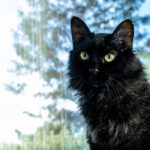It’s a classic cat owner experience: witnessing your feline friend’s unexpected fascination with human food. From nibbling on houseplants to batting at your dinner, cats have curious palates. Among the more peculiar feline food obsessions, cantaloupe often tops the list. But is this juicy melon safe for your carnivorous companion? If you’ve ever wondered, “Can Cats Eat Cantaloupe?”, you’re not alone. Let’s dive into the mystery behind your cat’s cantaloupe cravings and explore whether this fruit is a feline-friendly treat.
The Cantaloupe Conundrum: Why Are Cats Mesmerized?
Cats are obligate carnivores, meaning their bodies are designed to thrive on a meat-based diet. So, why would a creature built for protein pounce on a slice of sweet melon? The answer lies in the fascinating world of aroma and feline senses. While we might perceive cantaloupe as fruity and sugary, your cat’s nose detects something entirely different: the scent of meat.
This olfactory illusion is due to volatile organic compounds released by cantaloupe as it ripens. These “volatiles” are essentially airborne molecules that carry scent. Interestingly, cantaloupe contains volatiles derived from amino acids, the very building blocks of protein found abundantly in meat. For a cat, whose sense of smell is far more attuned to these compounds than ours, cantaloupe can emit a meat-like aroma, triggering their natural hunting instincts and drawing them in for a taste. It’s a clever trick of nature, and perhaps explains why cats from across the globe seem to share this peculiar fondness for cantaloupe.
Is Cantaloupe Safe for Cats? The Nutritional Paw-spective
While cantaloupe might pique your cat’s interest, it’s crucial to understand its place in their diet. The good news is that cantaloupe is generally considered non-toxic to cats. A small amount of cantaloupe flesh is unlikely to harm your feline friend. In fact, cantaloupe is low in calories and contains water and certain vitamins, such as vitamin A and vitamin C, as well as potassium. These nutrients, while beneficial in a balanced diet, are not essential for cats and are readily obtained from their primary meat sources.
However, moderation is key. Cats have sensitive digestive systems, and their bodies are not designed to process large amounts of sugar and fiber found in fruits like cantaloupe. Overindulgence can lead to gastrointestinal upset, including diarrhea, vomiting, or stomach discomfort. Furthermore, cantaloupe seeds and rind should be avoided as they can pose a choking hazard or cause digestive blockages.
Serving Cantaloupe to Your Cat: A Treat, Not a Meal
If you decide to offer your cat a taste of cantaloupe, consider it an occasional treat, not a regular part of their diet. Here’s how to safely introduce cantaloupe to your feline:
- Small Portions: Offer only a bite-sized piece or two of the fleshy part of the cantaloupe. Think of it as a tiny snack, not a serving.
- Preparation: Remove the rind and seeds completely. Cut the cantaloupe into easily manageable, small pieces to prevent choking.
- Observation: After offering cantaloupe for the first time, observe your cat for any signs of digestive upset. If they experience vomiting or diarrhea, discontinue offering cantaloupe.
- Frequency: Cantaloupe should be an infrequent treat, offered sparingly, perhaps once in a while. Their primary nutrition should always come from high-quality cat food formulated for obligate carnivores.
Cantaloupe and Cats: A Sweet Treat in Moderation
So, can cats eat cantaloupe? Yes, in small amounts, cantaloupe is generally safe for cats and can be an occasional, intriguing treat. While their fascination might stem from a mistaken meat-like aroma, cantaloupe offers a touch of sweetness and hydration. However, it’s vital to remember that cats are carnivores, and their diet should primarily consist of meat-based protein. Cantaloupe should never replace a balanced cat food diet and should be offered sparingly to avoid potential digestive issues. If your cat shows an unusual interest in cantaloupe, a tiny taste is unlikely to harm them, but always prioritize their carnivorous needs for optimal health and well-being.
Related Reads:
- Answers: Plant vs. Meat – The Protein Feud for Cat Food
- Answers: What Dry Food Does to Your Cat’s Fur
- Answers: Why Won’t My Cat Eat?
- Lysine and Raw Cat Food Diets
References:
- I Gonda, E Bar, V Portnoy, S Lev, J Burger, AA Schaffer, Y Tadmor, S Gepstein, JJ Giovannoni, N Katzir and E Lewinsohn, “Branched-chain and Aromatic Amino Acid Catabolism into Aroma Volatiles in Cucumis Melo L. Fruit,” Journal of Experimental Botany 61, No. 4, March 2010, 1111-1123.
- S Lignou, JK Parker, C Baxter and DS Mottrama, “Sensory and Instrumental Analysis of Medium and Long Shelf-life Charentais Cantaloupe Melons (Cucumis melo L.) Harvested at Different Maturities,” Food Chemistry 148, No. 100, Apr 1, 2014, 218-229.


